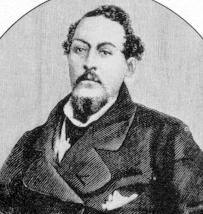Tom Hyer
He became a heavyweight boxing champion after defeating Country McCloskey in a long brutal fight in New York on September 9, 1841, though there was no sanctioning body to recognize his championship.
His father Jacob Hyer also worked as a butcher, and briefly earned a living as a boxer, reportedly fighting an opponent named Tom Beasley in 1816, using the older Broughton rules of England, in what is now considered the first official boxing match known to have been held in America.
[6][7][8][9] In his boxing prime, as seen at left, Tom Hyer had a huge chest, and long, muscular rangy arms with extremely wide shoulders, that gave him both strength and reach.
Hyer was recognized as the bare-knuckle boxing Heavyweight Champion of America after a 101-round victory over George McCheester, known as Country McCloskey, at Caldwell's Landing in New York City, on September 9, 1841.
The intense battle in the scorching sun of the open air arena reportedly lasted 2 hours, fifty minutes before McCloskey's seconds threw up the sponge ending the bout in the 101st round.
The first 11 rounds seemed to favor McClosky, but the tide turned by the 28th when Hyer unleashed a tremendous, left-hander on Country's nose, which caused serious bleeding.
The death of Tom McCoy following his loss to Chris Lilly in Westchester County on September 13, 1842, led to a more vigorous enforcement of the laws against prizefighting, and ultimately delayed the matching of Hyer with Yankee Sullivan.
[1][16] Hyer first met "Yankee Sullivan", an Irishman with the real name James Ambrose, at an Oyster Bar at the corner of New York's Broadway and Park Place early in 1849.
[10] According to one source, Sullivan was a bit of a ruffian and petty criminal when he was boxing in London during his early fighting days, and was sent to a British penal colony in Australia, to serve time.
Opposing political factions often made up gangs and expressed their animosity using warfare in the streets, on occasion taking over balloting places to secure their candidates would win.
The match went 16 rounds at Still Pond Creek, a cold and snowy outdoor arena on the East Maryland shore, ten miles below Poole's Island where the fight was originally planned.
Sullivan hoped to use what he believed to be an advantage in grappling, to weaken the larger Hyer by way of hard throws, legal in London Prize Ring Rules.
According to the Milwaukee Sentinel, writing the day after the fight, once Sullivan was exhausted, Hyer caught his head under his arm before he could fall in the 15th, and punched him repeatedly.
Hope Hospital where he was treated for his injured arm, badly blackened eyes and a slight skull fracture, but released the following day.
[28][29] The fight lasted 17 minutes, 18 seconds and Hyer won an exceptionally large $10,000 purse in a battle that he dominated, though Sullivan took his $10,000 as well.
Much of the way back from Chesapeake Bay to New York, Hyer was greeted and cheered by large crowds that lined the streets of cities and towns, for parades of victory.
[9] This was a widely publicized boxing match at the time and helped to ignite the sport's popularity, despite the bout being illegal in Maryland, and clearly a brutal affair.
[1][10][9] Two days later, Hyer was celebrated when he arrived in Philadelphia by a triumphal procession after his victory over Sullivan, and there were even exaggerated reports in the newspapers of his becoming a Whig candidate for the Presidency of the United States.
Once the celebrations ended, Hyer was required to attend a hearing in Philadelphia before a judge who was waiting for a requisition from the Governor of Maryland to prosecute him for the fight.
[32] In 1850, Hyer challenged the "Tipton Slasher", William Perry, reigning Heavyweight Champion of England, but no fight was held.
[40] On mid-January, 1855, Hyer was reported to have been struck and injured in the head twice by the butt of a heavy revolver in an incident at New York's Platt's Hall below Wallick's Theater, by the former boxer Lew Baker, a rival of the Bowery Boys gang.
[44][45] Hyer was not known to have been present two weeks later at another gang incident at New York's Stanwix Hall at 1:00 on February 24, where Poole was shot and wounded in the leg by Lew Baker, and further assaulted by others He eventually died at his home.
[47] Taking advantage of his political connections, in 1857 Hyer was appointed Superintendent of Lands and Places, by New York Street Commissioner Connor.
[49] In the same year, according to one source, Hyer attempted to schedule fights with the "Benicia Boy", John C. Heenan, but satisfactory terms were not met.
According to one account, he became a good friend of both Abraham Lincoln and Secretary of State William Seward, which seems plausible considering his national prominence and his political connections with the Whig Party.
To help raise money for his care and his family, a benefit was given to him shortly before his death around June 21, 1864, at New York's Stuyvesant Hall, where thousands gathered to see him briefly address the crowd from his wheel chair, accompanied by thunderous applause.







